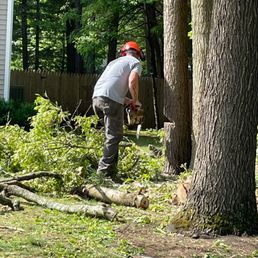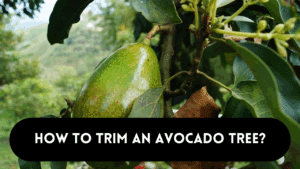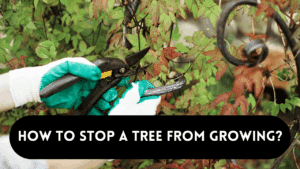Dealing with vines on tall trees may be a tough and rewarding endeavor in the realm of arboriculture. Vines not only restrict the tree’s growth but can also be harmful to its health. In this detailed tutorial, we will look at the numerous varieties of vines, how to recognize them, the ideal time to remove them, and the most successful methods to remove vines from tall tree.
Types of vines
Understanding the Varieties
Vines exist in a variety of shapes and sizes, each with its own set of features. Some vines are native to specific places, while others are invasive species that can wreck havoc on your trees. Understanding the diversity of vines will allow you to make more educated judgments concerning their management.
Native vs. Invasive Vines
It’s critical to distinguish between native and invasive vines. Native vines are often less hazardous to trees since they have evolved to coexist with them. Invasive vines, on the other hand, can outcompete natural flora and destroy tree structures. We will go deeper into the ecological implications of these distinctions, highlighting the significance of protecting native ecosystems.
How to Identify Vines
Visual clues
Observe the vine’s color, texture, and any distinctive marks on the leaf or stem. Documenting these qualities will aid in correct identification. We’ll also go through the significance of different leaf shapes, sizes, and patterns and how these traits can provide important clues regarding the vine’s species.
Leaf characteristics
A crucial step is to examine the vine’s leaves. Leaves come in a variety of shapes, sizes, and patterns, and these characteristics can help identify the vine’s species. We will provide extensive descriptions and photographs of common vine leaves to aid with identification.
Development Patterns
Vines can develop in a variety of ways, including climbing, trailing, and twining. Understanding how a vine attaches itself to a tree might provide crucial identification clues.
Furthermore, we’ll expose you to online tools and smartphone apps that can aid in the identification process, making it even more accessible to tree aficionados.
Tools and Safety Precautions:
Before you begin, gather the following tools and take the following precautions:
Tools:
- Pruning shears or loppers: Select the proper instrument based on the thickness of the vines. Pruning shears work well for smaller vines, while loppers work well for larger vines.
- Wear durable gloves to protect your hands from thorns, irritants, and other potential hazards.
- Safety glasses: Protect your eyes from debris that may fall while trimming vines.
- A ladder is useful for safely climbing vines on taller trees.
- Wear long-sleeved clothing to avoid skin contact with potentially irritating flora.
Precautions for safety:
- Examine the tree’s general health before removing any vines. Ascertain that it is stable and not in danger of toppling.
Steps to Remove Vines from Tall Tree
Manual Methods
1. Check for wildlife:
Vines can provide habitat for birds, insects, and small animals. Before removing the vines, look for any signs of nests or residents.
Be wary of poison ivy or poison oak. Some vines, such as poison ivy, can cause skin discomfort. Learn to identify these plants and use extreme caution.
2. Find the Vine’s Base:
Follow the vine to its base at ground level. This is where you should begin your removal process.
3. Cut the base
Make an accurate cut at the base of the vine, close to the surface, with your pruning shears or loppers. Make certain that the vine is totally severed.
4. Remove the vine from the Tree:
Carefully pull the severed vine away from the tree. It may be loosely interwoven or entrenched in the bark of the tree. During this process, take care not to damage the tree’s bark or branches.
5. Dispose of Cuttings:
Place the cut vines in a compost pile or properly dispose of them. Leave them on the ground since certain vines can re-root and thrive.
After removing the vines, look for any damage the vines may have caused to the tree. Examine the bark for wounds or abrasions. If you spot any injuries, clean them up and treat them to keep disease and pests out of the tree.
Keep an eye out for regrowth. Keep an eye out for evidence of vine regrowth on the tree. Some vines are tenacious, and you may need to repeat the eradication operation as needed.
Regularly examine your trees and remove any new vines that appear to avoid further vine growth.
6. Seasonal Considerations
When it comes to vine removal, time is of the essence. Because the vine’s growth rate and susceptibility to removal fluctuate throughout the year, certain seasons are better suited for performing this chore. We’ll provide you with a complete calendar with the best times for vine removal based on your location.
7. Dormancy and Growth Cycles
Understanding the dormancy and development cycles of both vines and trees is critical for efficient removal. We’ll show you how to align your efforts with these natural rhythms, assuring a higher success rate in eliminating vines without causing additional harm to your tree.
8. Preventing Re-Growth
Removing vines is only one part of the solution; preventing their reappearance is equally vital. We’ll look at proactive strategies, including regular inspections, pruning procedures, and the construction of physical barriers to restrict vine growth, allowing your trees to thrive without constant intervention.
Chemical Removal Of Vines
When it comes to eradicating vines from tall trees with herbicides,it depends on the type of vine you’re dealing with as well as your individual conditions. Herbicides utilized frequently for vine clearance include the following:
1. Herbicides based on glyphosate:
Brand names include Roundup, Rodeo, and Touchdown.
Use: Glyphosate-based herbicides are broad-spectrum herbicides that work on a variety of vines. They act by blocking the growth of plant cells, causing the vine to die. These pesticides are often administered to the vine’s leaves or cut surfaces.
2. Herbicides Based on Triclopyr
Brand names include Garlon, Brush-B-Gon, Crossbow, and others.
Herbicides based on triclopyr are efficient against woody vines and bushes. They are frequently used to describe strong, woody vines such as poison ivy and kudzu. These herbicides can be applied to cut surfaces or as a foliar spray.
3. Herbicides Based on Imazapyr
Brand names include Arsenal, Polaris, and Chopper.
Herbicides based on imazapyr are effective at controlling invasive and woody vines. They are widely utilized in natural area management and are well-known for providing long-term control. These herbicides are applied to cut surfaces or as foliar sprays.
4. Herbicides based on 2,4-D:
Brand names include Weed-B-Gon, Weedone, and others.
Herbicides based on 2,4-D are effective against a wide range of broadleaf vines. They are commonly administered as foliar sprays to non-woody vines.
5. Herbicides based on dicamba:
Brand names include Banvel, Diablo, and Vanquish.
Use: Herbicides based on dicamba are effective against a wide variety of broadleaf vines and can be applied in both agricultural and non-agricultural situations. They are sprayed on the leaves.
6. Herbicides Based on Picloram
Tordon, Grazon, and other brand names are examples.
Picloram-based herbicides work well against woody and broadleaf vines. They are frequently employed in forestry and range management. These herbicides can be applied to cut surfaces or as a foliar spray.
FAQS
Can vines harm tall trees?
Yes, vines can harm tall trees by obstructing their growth, stealing nutrients, and potentially causing structural damage. It’s essential to address vine infestations promptly.
Are all vines harmful?
No, not all vines are harmful. Some native vines coexist with trees without causing harm, while invasive vines are more detrimental. Identifying the type of vine is crucial for effective management.
When is the best time to remove vines?
The best time to remove vines is during their dormant season or late winter, when they are less resilient. However, specific timing may vary based on your location and climate.
Is manual removal safe for the tree?
Manual removal can be safe if done carefully. Avoid damaging the tree’s bark or branches during the process, and consider seeking professional advice for complex situations.
How can I prevent vines from returning?
Preventive measures include regular inspections, pruning, and creating physical barriers to stop vine growth. Implementing these strategies will help maintain a vine-free environment for your trees.
Conclusion
The process to remove vines from tall trees is important in preserving the health and vitality of these arboreal wonders. Vines, if left unchecked, can not only hinder the growth of trees but also pose a risk to their structural integrity.
Whether you opt for manual removal techniques or herbicides, a few key principles remain constant. Accurate identification of the vine species is essential to choosing the most appropriate removal method,ensuring minimal harm to the tree




